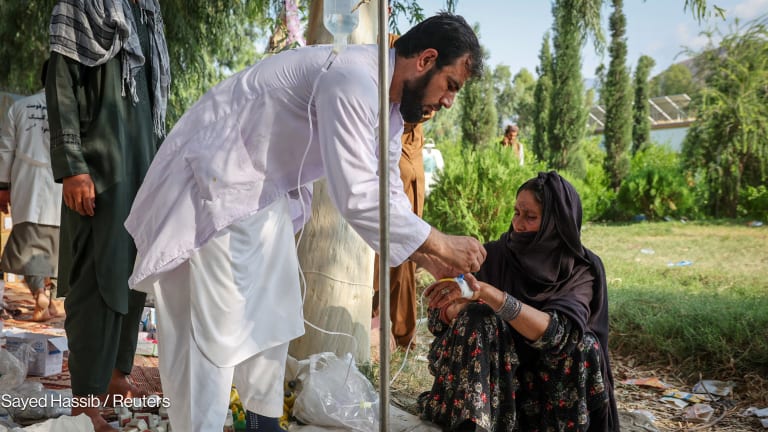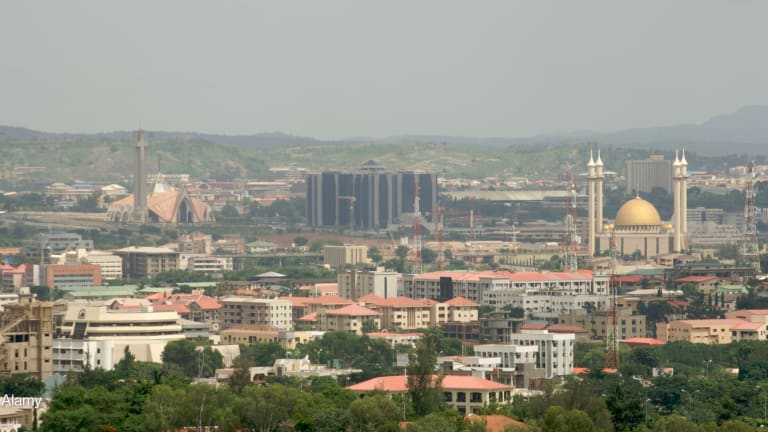Has the international community failed Yemen?
As the conflict in Yemen rages on, Devex takes a closer look at how past international support — or lack thereof — might have precipitated the country's free fall into chaos, and what the donor community could do to prevent a "total collapse."
In late 2011, pro-democracy demonstrations that swept across the Middle East and North Africa forced strongman Ali Abdullah Saleh to step down after 33 years at Yemen’s helm. What ensued was an internationally brokered agreement in which then-Vice President Abed Rabbo Mansour Hadi was put in charge of steering the country’s transition toward a new political system. But three years on, national reconciliation efforts — which culminated in the publication of a draft constitution earlier this year — failed to achieve consensus. Dissatisfaction of rival political groups with the proposed federal structure ultimately led Houthi fighters, whose power base lies in the northern highlands, to seize power and expand militarily into Yemen’s south. In light of Yemen’s history — one of rival factions and shifting alliances, with occasional shaky dominance by a region or tribe — experts have noted that the crumbling of Hadi’s government hardly comes as a surprise. But amid the intensification of armed clashes and Saudi-led airstrikes, Zeid Raad al-Hussein, the U.N. high commissioner for human rights, has warned that the country is “on the verge of total collapse.” A quick overview of Yemen’s recent socio-economic challenges however reveals that the country’s breakdown has been years in the making. And as media coverage continues to focus on how the Yemeni conflict is morphing into a regional proxy war between Iran and Saudi Arabia, Devex decided to take a closer look at the role and responsibility of past international aid efforts in the unfolding of the current crisis. When aid fails to meet politics In the face of recurrent political turmoil, donor support for the Arab world’s poorest nation has often been characterized by a “wait-and-see” attitude. Following the 2011 popular uprising, Yemen was already inching dangerously close to an economic and humanitarian disaster. But concerns over security, corruption and human rights violations led many prominent donors — including the World Bank and the European Union — to pull the plug on vital aid programs. As the international community awaited a political resolution, urgent appeals from aid groups remained unanswered for months on end. “Donors remain deeply divided over their approaches to the region’s poorest country, thus delaying responses and hindering funding,” Oxfam noted in a report published in late 2011, adding that “hundreds of millions of dollars in assistance have been suspended.” In September 2012, Western and Arab states that gathered at the Friends of Yemen conference promised $7.9 billion in aid. But hopes to turn the tide were short-lived. Aside from the notable exception of Saudi Arabia, donors remained extremely slow to release funds — tying the resumption of aid to the completion of political and security reforms. In 2014, Masood Ahmed, director for the Middle East and North Africa at the International Monetary Fund, said that only a third of pledged funds had been disbursed. Meanwhile, incessant political quarrels — which have been left to persist both by local elites and the international community — have led to the exacerbation of the country’s socio-economic challenges. “Both development and humanitarian responses have failed primarily because the political instability was not enough of a priority,” Mohamed Salah Eldin, Yemen country director at Islamic Relief, told Devex. Erratic funding Persistently ranking at the bottom of the Human Development Index, Yemen is one of the poorest countries in the world — with high levels of malnutrition, mass unemployment, and growing oil and water shortages. “Yemen is a country that even before this current conflict was moving toward a humanitarian crisis,” April Longley Alley, senior analyst on the Arabian peninsula at the International Crisis Group, noted in a recent interview. “It’s a country that is 90 percent dependent on imports for its food and it’s already running out of water in critical cities.” Such stark development challenges required sustained and substantial development assistance. However, foreign aid flows to Yemen have so far been characterized by notable shortfalls. Based on official development assistance figures published by the Organization for Economic Cooperation and Development, Devex comparison of donor commitments and disbursements found that the funding gap reached a staggering $2.2 billion in the 2008-2013 period — or a third of all pledges. Unfulfilled commitments were most visible in sectors deemed essential for the country’s sustainable and long-term development — including economic infrastructure and services ($1.3 billion), water and sanitation ($255.2 million), government and civil society ($160.1 million), and health ($142.1 million). But when donors are poised to donate, their activities are often hampered by a range of genuine obstacles. For instance, Islamic Relief’s Eldin believes that capacity constraints stemming from the prevalence of insecurity and weak governance constituted a major stumbling block to the delivery of aid. “General instability in Yemen has really reduced the capacity of aid agencies to absorb funding,” he said. Counterterrorism focus ‘at the expense of everything else’ However, some experts emphasized how international efforts have largely been dominated by the United States’ counterterrorism agenda, rather than centered on the real needs of the Yemeni people. “Basically the international community focused on [al-Qaida in the Arabian Peninsula] and terrorism,” Helen Lackner, an independent researcher and social development consultant who spent 15 years working in Yemen, explained. “Prioritization of security aspects has been at the expense of everything else.” Overall, donors seem to have largely adopted a hands-off approach in Yemen, despite high-level exhortations for a more proactive approach in the country. “Yemen needs exceptional and substantial financial and technical support now,” Inger Andersen, World Bank vice president for the Middle East and North Africa, said in the wake of the 2013 Friends of Yemen conference. But Devex data analysis found that the international community demonstrated little interest in improving the central government’s institutions and capabilities. In the 2008-2013 period, donors resorted to budget support only twice, while technical assistance barely exceeded $47 million. According to Lackner, international focus on large, parallel initiatives further deflected attention away from the need to deepen donor engagement with Yemen’s institutional structures. “The Social Fund for Development and projects like the [World Bank’s] Public Works Project provide much higher salaries, get the best qualified and English-speaking staff, and operate as parastatals,” she highlighted to Devex. What now? As the current conflict in Yemen rages on, there is little hope that donors can — and will — pick up the pieces. Before the recent flare up, the U.N. humanitarian response plan for 2015 was assessed at $748 million to assist 8.2 million people in need of various forms of emergency assistance. So far, it has only been funded to the tune of 9 percent. With such limited funding, Yemen is unlikely to avoid a full-blown humanitarian crisis. The United Nations has warned that basic services are unraveling, with widespread food and fuel shortages. In the meantime, relief supplies have barely started to trickle in. On April 11, two planes carrying urgent medical equipment from the International Committee of the Red Cross and UNICEF finally managed to land in the capital Sanaa. Although critical to securing Yemen’s future, renewed donor engagement will have to go beyond financial considerations in order to operate a gradual shift in approach. Improved, innovative methods — such as the U.K. Department for International Development’s pilot program to roll out multiyear humanitarian strategies or the World Food Program’s two-year operation focused on moving from relief to resilience — hold much potential to ensure that international donor support becomes aligned with the Arab country’s needs and specificities. According to the latest casualty reports published by the World Health Organization, violence has killed 643 people and injured 2,226 — including many civilians — since March 19. Displacement is also on the rise, with local organizations estimating the number of people displaced by the conflict at 100,000. Check out more insights and analysis for global development leaders like you, and sign up as an Executive Member to receive the information you need for your organization to thrive.
In late 2011, pro-democracy demonstrations that swept across the Middle East and North Africa forced strongman Ali Abdullah Saleh to step down after 33 years at Yemen’s helm. What ensued was an internationally brokered agreement in which then-Vice President Abed Rabbo Mansour Hadi was put in charge of steering the country’s transition toward a new political system.
But three years on, national reconciliation efforts — which culminated in the publication of a draft constitution earlier this year — failed to achieve consensus. Dissatisfaction of rival political groups with the proposed federal structure ultimately led Houthi fighters, whose power base lies in the northern highlands, to seize power and expand militarily into Yemen’s south.
In light of Yemen’s history — one of rival factions and shifting alliances, with occasional shaky dominance by a region or tribe — experts have noted that the crumbling of Hadi’s government hardly comes as a surprise. But amid the intensification of armed clashes and Saudi-led airstrikes, Zeid Raad al-Hussein, the U.N. high commissioner for human rights, has warned that the country is “on the verge of total collapse.”
This story is forDevex Promembers
Unlock this story now with a 15-day free trial of Devex Pro.
With a Devex Pro subscription you'll get access to deeper analysis and exclusive insights from our reporters and analysts.
Start my free trialRequest a group subscription Printing articles to share with others is a breach of our terms and conditions and copyright policy. Please use the sharing options on the left side of the article. Devex Pro members may share up to 10 articles per month using the Pro share tool ( ).
Manola De Vos is an Engagement Lead for Devex’s Analytics team in Manila. She leads and designs customized research and analysis for some of the world’s most well-respected organizations, providing the solutions and data they need to grow their partner base, work more efficiently, and drive lasting results. Prior to joining Devex, Manola worked in conflict analysis and political affairs for the United Nations, International Crisis Group and the EU.








